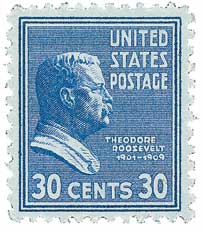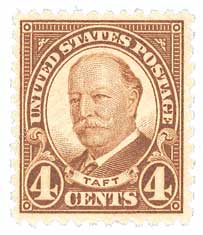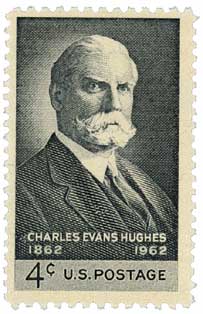
# 1305b - 1965-78 6c Franklin D. Roosevelt,precncl
6¢ Franklin Roosevelt
Prominent Americans Series Coil
City: Washington, DC
Printed By: Bureau of Engraving and Printing
Printing Method: Rotary Press
Perforation: 10 vertically
Color: Gray brown
Birth Of Charles Evans Hughes
Hughes attended Madison (now Colgate) University before transferring to Brown University, where he graduated third in his class. He then attended Columbia Law School, from which he graduated with highest honors in 1884.
After graduating Hughes joined a law firm and was made a partner within four years. From 1891 to 1893 he took a brief break from practicing law to teach at Cornell Law School. After that, he returned to his law career, though he would also work as a special lecturer from time to time at Cornell and New York University Law School.

In 1905 Hughes was selected to join the New York legislative “Stevens Gas Commission” to look into utility rates. Hughes discovered corruption in the system and helped to lower gas rates. Hughes then ran for governor of New York in 1906, defeating William Randolph Hearst. In 1908 William Howard Taft offered him the vice presidential nomination, but he refused it to run for governor again. Theodore Roosevelt became one of his greatest supporters.
Hughes introduced sweeping changes as governor. He fought political corruption and introduced new campaign laws that made candidates keep track of their expenses (this law was then introduced in 15 other states). Hughes pushed for the Moreland Act, which ultimately allowed him to remove corrupt city and county officials from office. He also fought increase the powers of the state’s Public Service Commissions. And he reorganized the Department of Labor and established new labor laws within the state, including eight-hour days and 40-day weeks for workers under 16 as well as barring young workers from dangerous jobs. During his last year as governor Hughes signed the Worker’s Compensation Act.

In April 1910, President William Howard Taft nominated Hughes for Associate Justice to fill a vacancy. The Senate approved him and he was confirmed on May 2. As an Associate Justice, Hughes fought laissez-faire capitalism and supported the expansion of state and federal regulatory powers.
Hughes resigned from the Supreme Court to run for president in 1916. Though he had the support of Theodore Roosevelt and William Howard Taft, he lost the election (by a small margin) to Woodrow Wilson. He would return to politics five years later when Warren G. Harding appointed him Secretary of State. In that role he attended the Washington Naval Conference and signed an agreement ending America’s occupation of the Dominican Republic.

Hughes remained in his post for part of Calvin Coolidge’s term as president but eventually resigned. He then served as president of the New York State Bar Association and as a judge on the Court of International Justice, as well as practicing law with his former firm. Then in 1930, Herbert Hoover appointed him Chief Justice of the Supreme Court. Hughes went on to lead the Supreme Court through a difficult time, when President Franklin D. Roosevelt introduced a great deal of legislation the justices found unconstitutional. Hughes retired from the court in 1941. Click here to read about some of the significant cases from his tenure.
Hughes died on August 27, 1948, in Osterville, Massachusetts.
6¢ Franklin Roosevelt
Prominent Americans Series Coil
City: Washington, DC
Printed By: Bureau of Engraving and Printing
Printing Method: Rotary Press
Perforation: 10 vertically
Color: Gray brown
Birth Of Charles Evans Hughes
Hughes attended Madison (now Colgate) University before transferring to Brown University, where he graduated third in his class. He then attended Columbia Law School, from which he graduated with highest honors in 1884.
After graduating Hughes joined a law firm and was made a partner within four years. From 1891 to 1893 he took a brief break from practicing law to teach at Cornell Law School. After that, he returned to his law career, though he would also work as a special lecturer from time to time at Cornell and New York University Law School.

In 1905 Hughes was selected to join the New York legislative “Stevens Gas Commission” to look into utility rates. Hughes discovered corruption in the system and helped to lower gas rates. Hughes then ran for governor of New York in 1906, defeating William Randolph Hearst. In 1908 William Howard Taft offered him the vice presidential nomination, but he refused it to run for governor again. Theodore Roosevelt became one of his greatest supporters.
Hughes introduced sweeping changes as governor. He fought political corruption and introduced new campaign laws that made candidates keep track of their expenses (this law was then introduced in 15 other states). Hughes pushed for the Moreland Act, which ultimately allowed him to remove corrupt city and county officials from office. He also fought increase the powers of the state’s Public Service Commissions. And he reorganized the Department of Labor and established new labor laws within the state, including eight-hour days and 40-day weeks for workers under 16 as well as barring young workers from dangerous jobs. During his last year as governor Hughes signed the Worker’s Compensation Act.

In April 1910, President William Howard Taft nominated Hughes for Associate Justice to fill a vacancy. The Senate approved him and he was confirmed on May 2. As an Associate Justice, Hughes fought laissez-faire capitalism and supported the expansion of state and federal regulatory powers.
Hughes resigned from the Supreme Court to run for president in 1916. Though he had the support of Theodore Roosevelt and William Howard Taft, he lost the election (by a small margin) to Woodrow Wilson. He would return to politics five years later when Warren G. Harding appointed him Secretary of State. In that role he attended the Washington Naval Conference and signed an agreement ending America’s occupation of the Dominican Republic.

Hughes remained in his post for part of Calvin Coolidge’s term as president but eventually resigned. He then served as president of the New York State Bar Association and as a judge on the Court of International Justice, as well as practicing law with his former firm. Then in 1930, Herbert Hoover appointed him Chief Justice of the Supreme Court. Hughes went on to lead the Supreme Court through a difficult time, when President Franklin D. Roosevelt introduced a great deal of legislation the justices found unconstitutional. Hughes retired from the court in 1941. Click here to read about some of the significant cases from his tenure.
Hughes died on August 27, 1948, in Osterville, Massachusetts.












